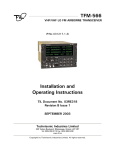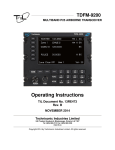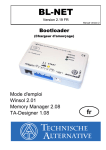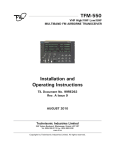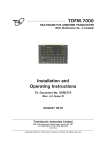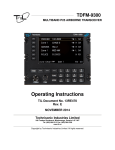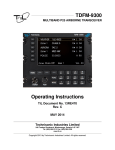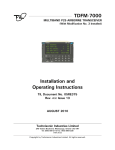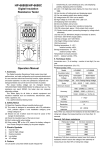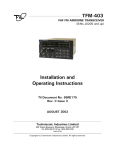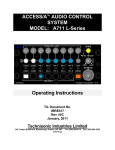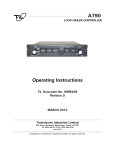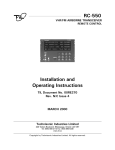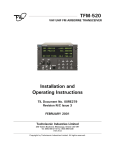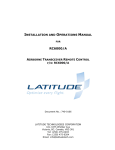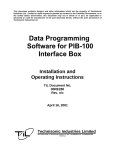Download TFM-66 Installation and Operating Instructions
Transcript
TFM-66 VHF/FM AIRBORNE TRANSCEIVER Installation and Operating Instructions TiL Document No. 03RE320 Revision N/C Issue 3 MARCH 2003 Technisonic Industries Limited 240 Traders Boulevard, Mississauga, Ontario L4Z 1W7 Tel: (905) 890-2113 Fax: (905) 890-5338 www.til.ca Copyright by Technisonic Industries Limited. All rights reserved. REVISION HISTORY [ 03RE320 ] REV SECTION - PAGE - DESCRIPTION REV n/c Issue 1 Issue 2 Issue 3 DATE EDITED BY MAR 2003 Global 3-6,3-7 New document template, added headers / footers, revision page and warranty page. Split Fig 3.2 to make it bigger, easier to read. i APR 2012 FM ii CAUTION ! STATIC SENSITIVE ! This unit contains static sensitive devices. Wear a grounded wrist strap and/or conductive gloves when handling printed circuit boards. FCC COMPLIANCE INFORMATION This equipment has been tested and found to comply with the limits for a Class A digital device, pursuant to Part 15 of the FCC Rules. These limits are designed to provide reasonable protection against harmful interference when the equipment is operated in a commercial environment. This equipment generates, uses, and can radiate radio frequency energy and, if not installed and used in accordance with the instruction manual, may cause harmful interference to radio communications. Operation of this equipment in a residential area is likely to cause harmful interference in which case the user will be required to correct the interference at his own expense. WARNING Changes or modifications not expressly approved by Technisonic Industries could void the user’s authority to operate the equipment. WARRANTY INFORMATION The Model TFM-66 Transceiver is under warranty for one year from date of purchase. Failed units caused by defective parts, or workmanship should be returned to: Technisonic Industries Limited 240 Traders Boulevard Mississauga, Ontario L4Z 1W7 Tel: (905) 890-2113 Fax: (905) 890-5338 iii iv TECHNISONIC INDUSTRIES LIMITED www.til.ca TABLE OF CONTENTS SECTION SECTION 1 1.1 1.2 1.3 1.4 1.5 GENERAL DESCRIPTION 1-1 1-1 1-1 1-1 1-2 OPERATING INSTRUCTIONS OPERATING FEATURES.................................................................................... OPERATING INSTRUCTIONS ............................................................................ PROGRAMMING INSTRUCTIONS ...................................................................... SCANNING FUNCTION .................................................................................... PRIORITY AND SELECTIVE MEMORY CHANNEL SCANNING ................................ DIRECT FREQUENCY ENTRY MODE .................................................................. RECEIVE FREQUENCY SIMPLEX FUNCTION ....................................................... KEYBOARD LOCKOUT FUNCTION .................................................................... VARIABLE FREQUENCY MODE FUNCTION ........................................................ LED DISPLAY VARIABLE DIMMING MODE ......................................................... 90 SECOND TRANSMITTER TIMEOUT FEATURE ................................................ QUICK GUARD PROGRAMMING FEATURE ......................................................... PROGRAMMING CTCSS TONES/DPL CODES ..................................................... PC MEMORY/PROGRAMMING DOWNLOAD CAPABILITY ..................................... SECTION 3 3.1 3.2 3.3 3.4 3.5 3.6 3.7 3.7.1 3.7.2 3.7.3 3.7.4 3.7.5 3.7.6 3.7.7 3.7.8 3.7.9 3.8 3.9 PAGE INTRODUCTION ............................................................................................. DESCRIPTION ................................................................................................ PURPOSE OF EQUIPMENT ............................................................................... MODEL VARIATION ........................................................................................ TECHNICAL CHARACTERISTICS ...................................................................... SECTION 2 2.1 2.2 2.3 2.4 2.5 2.6 2.7 2.8 2.9 2.10 2.11 2.12 2.13 2.14 TITLE 2-1 2-3 2-4 2-5 2-5 2-5 2-6 2-6 2-6 2-6 2-6 2-6 2-7 2-8 INSTALLATION INSTRUCTIONS GENERAL ...................................................................................................... EQUIPMENT PACKING LOG ............................................................................. TRANSCEIVER INSTALLATION ......................................................................... INSTALLATION KIT - CONTENTS ..................................................................... ANTENNA INSTALLATION ............................................................................... INSTALLATION - PIN LOCATIONS AND CONNECTIONS ...................................... WIRING INSTRUCTIONS .................................................................................. Main Power +28VDC ..................................................................................... Main Ground .................................................................................................. PTT (Ground Keying) ....................................................................................... Front Panel Back Lighting ................................................................................ Audio Outputs (600 and 4 Ohms) ..................................................................... Audio Output Ground ...................................................................................... Mic Signal Input ............................................................................................. Memory Up/Memory Down .............................................................................. Data Input ..................................................................................................... WIRING INSTRUCTIONS - 9 PIN D CONNECTOR ................................................. INTERNAL PROGRAMMING AND GUARD ENABLE/DISABLE JUMPER .................... TFM-66 Installation & Operating Instructions 3-1 3-1 3-1 3-1 3-1 3-1 3-4 3-4 3-4 3-4 3-4 3-4 3-4 3-4 3-4 3-4 3-5 3-5 TiL 03RE320 Rev N/C Issue 3 v TECHNISONIC INDUSTRIES LIMITED www.til.ca 3.10 3.11 3.12 3.13 3.14 3.15 TRANSMITTER POWER ADJUSTMENTS ........................................................... TRANSMITTER MICROPHONE LEVEL ADJUSTMENT ........................................... TRANSMITTER SIDETONE LEVEL ADJUSTMENT ................................................ MAIN AND GUARD SQUELCH ADJUSTMENT .................................................... TRANSMITTER DEVIATION ADJUSTMENT ........................................................ GUARD RECEIVER AUDIO LIMIT FEATURE ........................................................ 3-9 3-9 3-9 3-11 3-11 3-11 APPENDIX A – POST INSTALLATION EMI TESTS .......................................................... 3-13 WARRANTY ................................................................................................................ LIST OF FIGURES FIGURE TITLE PAGE 2.1 2.2 Operator's Switches and Controls - TFM-66 ....................................................... TFM-66 Transceiver PC Up/Download Cable - Wiring Diagram .............................. 2-2 2-11 3.0 3.1 3.2 3.3 3.4 3.5 Transceiver mounted view of 15-and 9-pin connectors ........................................ Outline Drawing for TFM-66 Transceiver ........................................................... Wiring Connections for TFM-66 Transceiver ....................................................... Internal Enable/Disable Jumper and TX High/Low Power Adjust Locations .............. Microphone and Sidetone Level, Main and Guard Squelch Adjustment Access ........ Deviation Adjustment Potentiometer Location .................................................... 3-1 3-2 3-6 3-8 3-10 3-12 LIST OF TABLES TABLE 3.1 3.2 3.2 TITLE PAGE Wire connections on a 15 pin connector ............................................................ Wire connections on a 9 pin connector .............................................................. ATU Band Select Truth Table ........................................................................... TFM-66 Installation & Operating Instructions 3-3 3-3 3-5 TiL 03RE320 Rev N/C Issue 3 vi TECHNISONIC INDUSTRIES LIMITED www.til.ca SECTION 1 - GENERAL DESCRIPTION 1.1 INTRODUCTION This publication provides operating and installation information on the TFM-66 (with version B2 software) Transceiver manufactured by Technisonic Industries Limited. Version B2 software is factory installed in the TFM-66. The unit offers an extended frequency range with selectable channel spacing and is intended for use only by government agencies or contractors thereto, who have obtained licensing for operation in the 66-88 MHz band. 1.2 DESCRIPTION The TFM-66 Transceiver is a frequency agile, fully synthesized airborne transceiver capable of operating in the 66.000 MHz to 88.000 MHz frequency range in 2.5 KHz increments with 25 kHz, 20 kHz or 12.5 kHz channel spacing. The Transceiver can operate without restriction on any split frequency pair in the band and also incorporates a two channel programmable guard receiver. The TFM-66 Transceiver provides 120 operator accessible memory positions, each of which is capable of storing a transmit frequency, receive frequency, transmit frequency CTCSS tone or DPL code, receive frequency CTCSS tone or DPL code, an alphanumeric identifier for each channel and wideband (25, 20 KHz) or narrowband (12.5 KHz) channel spacing assignment. Operating frequency and other related data are presented on a 48 character, two line LED matrix display. Data entry and function control are performed via a 12 button keypad. Preset channels may also be scrolled and scanned through keypad function activation. Data may also be entered via an MS-DOS based computer with the provided software and optional PC Up/download cable, P/N 943165-2. 1.3 PURPOSE OF EQUIPMENT The TFM-66 VHF/FM Transceiver is designed to provide secondary airborne communications to facilitate operations which are typically performed in a low altitude environment. The transmitter section of this unit has a minimum of 8 watts and does not exceed 10 watts output power which may be reduced by a front panel switch to 1 watt in order to reduce interference to land based systems. 1.4 MODEL VARIATION There are four variations of the Model TFM-66 Transceiver. All units offer identical features and performance except for the following differences: TFM-66, P/N 031218-1 GREEN display with 28 Volt back lighting. TFM-66, P/N 031218-1 (5V) GREEN display with 5 Volt back lighting. TFM-66, P/N 031218-2 RED display with 28 Volt back lighting. TFM-66, P/N 031218-2 (5V) RED display with 5 Volt back lighting. Both P/N's 031218-1 and 031218-2 are always provided with 28 Volt back lighting unless a specific request is made for 5 Volt AC operation. TFM-66 Installation & Operating Instructions TiL 03RE320 Rev N/C Issue 3 1-1 TECHNISONIC INDUSTRIES LIMITED www.til.ca 1.5 TECHNICAL CHARACTERISTICS Characteristic Specification GENERAL Model Designation: TFM-66 Frequency Ranges: 66.000 to 88.000 MHz Tuning Increments: 2.5 kHz Operating Modes: F3E simplex or semi-duplex Channel Spacing: 25, 20 or 12.5 kHz Physical Dimensions (including heatsink): Approx. 8.0" X 3.0" X 5.75" Weight: Approx. 3.1 Lbs (1.4 Kg) Mounting: Panel Mount via Dzus fasteners Operating Temperature Range: -40°C to +60°C Power Requirement: Voltage: Current: 28.0 Vdc, ± 15% Receive - 0.7 A Max. 1 Watt Transmit - 1.5 A Max. 8-10 Watt Transmit - 2.5 A Max. Frequency Selection: 120 memories programmed with: a) Tx Frequency/Rx Frequency b) Tx/Rx CTCSS tone or DPL code c) 9 character alpha numeric title Guard Receiver: 2 channels programmed with: a) Tx Frequency/Rx Frequency b) Tx CTCSS tone or DPL code c) 9 character alpha numeric title CTCSS squelch/encoder (FM): All CTCSS tones available DPL digital squelch/encoder (FM): All standard DPL codes DTMF encoder: All standard DTMF tones Audio Outputs: 0.5 Watts into 600 ohms Speaker Output: 2.5 Watts min. into 4 ohms Back Lighting: 28 Volts (standard) or 5 Volts (specify) Display Colour: Green (standard) or Red (specify) 1 DPL is a trademark of Motorola Corporation TFM-66 Installation & Operating Instructions TiL 03RE320 Rev N/C Issue 3 1-2 TECHNISONIC INDUSTRIES LIMITED www.til.ca 1.5 TECHNICAL CHARACTERISTICS (continued) MAIN RECEIVER Sensitivity at 12 dB SINAD 0.4 μV nominal Adjacent Channel Selectivity -70 dB Spurious Attenuation -90 dB Third Order Intermodulation -70 dB Image Attenuation -80 dB FM Acceptance ± 6 kHz Hum and Noise Better than 50 dB Audio Distortion less than 5% Antenna Conducted Emission less than -70 dBm GUARD RECEIVER All specifications identical to main receiver TRANSMITTER RF Power Output 1 watt or 10 watts Output Impedance 50 ohms Maximum Deviation (In narrowband mode) ±5 kHz(25,20 kHz mode) ±2.5 kHz(12.5 kHz mode) Spurious Attenuation -80 dB below carrier level Frequency Stability ± 5 ppm Microphone Circuit Carbon or equivalent Sidetone Output 0.5W (max) into 600 Ohms Harmonic Attenuation -60 dB below carrier level FM Hum And Noise -40 dB Audio Input 50 mV at 2.5 kHz into 200 Ohms input circuit for ±3.5 kHz deviation, adjst. Audio Distortion Less than 5% Specifications are nominal and may be subject to change without notice. TFM-66 Installation & Operating Instructions TiL 03RE320 Rev N/C Issue 3 1-3 TECHNISONIC INDUSTRIES LIMITED www.til.ca This page left intentionally blank. TFM-66 Installation & Operating Instructions TiL 03RE320 Rev N/C Issue 3 1-4 TECHNISONIC INDUSTRIES LIMITED www.til.ca SECTION 2 – OPERATING INSTRUCTIONS 2.1 OPERATING FEATURES The equipment has several important operating features which provide maximum flexibility, performance and versatility. These features include: 1. 2. 3. 4. 5. 6. 7. 8. 9. 10. 11. 12. 13. 14. 15. 16. 120 memory positions which can each be programmed with a transmit and receive frequency with 25, 20 or 12.5 kHz channel spacing, Tx/Rx CTCSS tones or DPL codes and a 9-character alphanumeric title. 2 guard channels which can each be programmed with a Rx frequency with 25, 20 or 12.5 kHz channel spacing, CTCSS Tx tone or DPL code and a 9-character alphanumeric title. Scanning of preprogrammed memories with selective memory scanning, in 5 scan lists. Priority scan of memory channel 1, if desired. Direct frequency entry mode. Receive frequency simplex function. Switchable RF output power between 1 watt and 8-10 watts. Lockout of keyboard to prevent inadvertent entries. Variable frequency mode to manually scan up and down in 2.5 kHz steps. LED display variable dimming mode. Selectable 90 second Tx time out feature. Quick download of any of the 120 memory positions to the guard memories. PC Memory Upload or download capability. Guard jumper (J15) to en/disable Guard programming. Compatibility with industry standard Antenna Tuner Unit. Configuration Menu to en/disable various functions as follows: 1. Configuration Menu - Pressing ENTER, RCL and FUNC together with all 3 switches up while turning the radio on will put it into configuration mode. The programming features affected are: a) DPL - Can be turned on or off with th MUP and MDN (4 and 7) keys. This only removes the DPL entry step from the programming sequence and does not stop memories that already have DPL codes from working. This also applies to the rest of the on/off configurable items. b) SCAN - Can be disabled. Selecting FUNC and SCAN will do nothing if Scan is off. The scan list indicator (+) will still display if was previously programmed. c) Rx CTCSS - Can be turned on or off from the programming sequence. This affects only the CTCSS tones for receive. d) FUNC 7 - Can be turned on or off. When off, the main memory channel can not be dumped into one of the guard channels using function 7. e) LAST MEM - If set to on, the last memory channel on the display will be what comes up when the radio is turned on. If set to off, the last memory that changes were made to will be what comes up when the unit is switched on. 2. Guard Jumper - Programming of the guard channels can be totally disabled by removing J15. This way, the radio has to be disassembled in order to re-program either of the guard frequencies. This may be required on US Forest Service contracts. TFM-66 Installation & Operating Instructions TiL 03RE320 Rev N/C Issue 3 2-1 TECHNISONIC INDUSTRIES LIMITED www.til.ca FIGURE 2.1 Operator's Switches and Controls - TFM-66 TFM-66 Installation & Operating Instructions TiL 03RE320 Rev N/C Issue 3 2-2 TECHNISONIC INDUSTRIES LIMITED www.til.ca 2.2 OPERATING INSTRUCTIONS (See Figure 2.1) 1. Switch power on by turning the main volume clockwise. Depending how the radio is configured, either the last programmed or last displayed frequency will appear on the screen. The transceiver is now in normal operating mode. 2. Adjust the audio level by adjusting the main and guard volume knobs. 3. Pressing the squelch defeat button will open both receivers to confirm they work. 4. Read the display. The top line will indicate which memory is selected followed by a "+" if the memory position is included in a scan list, an alphanumeric message, and the frequency of the main receiver. A small "n" before the frequency indicates 12.5 kHz narrowband channel spacing is in effect on this memory position. In the receive mode, the frequency is followed by an "RT" if a RX CTCSS tone or RX DPL code is programmed, or an "RX" if no Receive tone/code is programmed. Similarly, in the transmit mode either a "TT" or "TX" is shown after the frequency. The bottom line indicates similar information about the guard receiver. 5. Only TX CTCSS tones or TX DPL codes may be programmed for the guard receiver. At the beginning of each line, an LED indicates open squelch. 6. Set the MN/GD switch to main or guard transmit frequency. 7. Set the G1/G2 switch to the desired guard channel. 8. Set the HI/LO switch to the desired RF output power. 9. Select the desired memory by using the M.UP and M.DN buttons, or the RCL button and a three digit number followed by ENTER. 10. To transmit DTMF tones, use the keyboard keys while holding the PTT button on the microphone. The keyboard returns to its normal function when the PTT is released. The display always shows the status of both receivers and the transmitter. The light at the left of the top and bottom line indicates which receiver is receiving. The display also indicates the memory channel in use and the guard channel in use. A "TX" (no TX tone/codes programmed) or "TT"(either TX tone or code programmed) on the right side of the display indicates whether the guard or main channel is active when transmitting. The transmit frequency is also shown. In the receive mode the display shows “RX” beside the receive frequency if no RX tone or DPL code is programmed and “RT” if a CTCSS tone or DPL code is programmed. When the transceiver is in either of the operating frequency or CTCSS tone/DPL code programming modes and you must respond to a call, click the microphone PTT once (the radio will not transmit during this click). This will cause the transceiver to revert back to the normal operating mode and communications with the caller can proceed in the usual fashion. The TFM-66 was designed for compatibilty with an industry standard Antenna Tuner Unit through the 9 pin connector on the rear panel of the radio. The ATU is enabled during transmit. TFM-66 Installation & Operating Instructions TiL 03RE320 Rev N/C Issue 3 2-3 TECHNISONIC INDUSTRIES LIMITED www.til.ca 2.3 PROGRAMMING INSTRUCTIONS To program one of the 120 memory channels in the TFM-66: 1. 2. 3. 4. 5. 6. 7. 8. 9. 10. 11. 12. Press the FUNC key. The display will show the function prompt. Press the PROG key. The display will show the current receive frequency with a flashing cursor on the second digit (The first digit is always a one <1>). Type in the desired receive frequency. If you type in a frequency which is not a 2.5 kHz step, the nearest valid frequency will be automatically selected. The cursor will return to the second digit. You can now retype the frequency if you made an error or press ENTER to continue. The transmit frequency will be displayed with the cursor on the second digit. Follow the same method as in step 3 and 4. The channel spacing increment of either 25, 20 or 12.5 kHz is now displayed. Use the M.UP and M.DN keys to select the desired channel spacing for the memory position, then press ENTER. The alpha-numeric title is now displayed. Use the M.UP and M.DN keys to scroll through the alphabet, numbers and symbols. When the desired character is displayed, press ENTER to advance to the next character. Press “1" to backspace. Keep repeating step six until the last space is set. The display will show SCAN or LOCKOUT to enable this memory position as part of a scan list or lock it out of the scan list. Use the 1,2,3,4,5 and M.DN keys to toggle between these functions (for details see paragraph 2.5). Once the desired condition has been selected, press ENTER. The TFM-66’s display will show a "+" beside the memory channel number if scan is enabled. The display will now show the current memory number. Type in the 3-digit number of the memory you want to save to (if different from displayed one) and press ENTER. You now have the option to program the guard frequencies by pressing FUNC or press ENTER to return to normal operating mode. If you pressed FUNC to program the guards, guard"1" transmit frequency will be displayed with the flashing cursor on the second digit. Enter the frequencies for guard"1" receive/transmit and guard"2" receive/transmit as in step 3 and 4. The alphanumeric labels for guard"1" and guard"2" are entered the same as in step 7 and 8. When the last character is entered, the radio returns to normal operating mode. If the guard is be be programmed for 12.5 kHz narrowband operation, use the QUICK GUARD PROGRAMMING FEATURE described in paragraph 2.12. A memory position must be programmed to the 12.5 kHz mode then the contents can be quickly downloaded to GD1 or GD2 memory positions. Programming of memory is disabled when the internal entry disable jumper is set. Alternatively any transceiver can be programmed by an IBM PC or compatible computer. See section 2.14 PC Memory/Programming Download Capability. TFM-66 Installation & Operating Instructions TiL 03RE320 Rev N/C Issue 3 2-4 TECHNISONIC INDUSTRIES LIMITED www.til.ca 2.4 PRIORITY SCANNING, SELECTIVE MEMORY CHANNEL SCANNING & SCAN LISTS Instead of breaking up the 120 channels into blocks for scanning, the TFM-66 software has 5 scan lists. Any of the 120 channels can be assigned to any one of more of these 5 scan lists. This means the channels do not have to be repeated for them to be in more than one block and that you are not limited to the number of channels that you can scan at once, since all 120 channels can be put into any scan list. The priority memory channel is always memory position number 1. The priority memory channel is scanned every other step (i.e. 121314151...) to ensure that no incoming messages are missed. The priority channel can be locked out, which will result in the normal scanning of the other memory positions. Selective memory scanning allows the user to select which of the 120 memory channels are to be scanned or locked out when the scan function is invoked. To use this feature, follow the PROGRAMMING INSTRUCTIONS found in paragraph 2.3. Once the screen displays SCAN or LOCKOUT, use the 1,2,3,4,5 or M.DN keys to toggle to the desired condition and press ENTER. Entering the any or all of the numbers 1,2,3,4 or 5 will include that memory channel in any of the five scan lists. In normal operating mode the display will later show a "+" beside the memory channel number if it has been included in any of the 5 scan lists. 2.5 SCANNING FUNCTION (5 second talkback delay) 1. To start scanning of the memory channels, press FUNC then SCAN and then the number (1,2,3,4,5) of the desired scan list. The radio will scan through all the preset memory positions in the selected scan list (see above paragraph for priority and selective scan features) and will lock on to the first active channel in the scan sequence. It will remain on the channel until it becomes inactive. Scanning will resume again after five seconds of inactivity. To exit the scan mode, press the SCAN key. This will cause the radio to revert back to the normal operating mode. Therefore, if while scanning, you hear a call for you: 1. 2. Respond to the call within 5 seconds. When scanning is interrupted by an incoming signal, the channel will remain open for five seconds before resuming scanning. During communications the five second timer is reset from the last Rx or Tx signal experienced. The radio resumes scanning once the Rx or Tx activity has ceased for more than five seconds. The SCAN key must be pressed to exit the scan mode. 2.6 DIRECT FREQUENCY ENTRY MODE This mode is designed to facilitate quick frequency selection during emergency and other operational conditions requiring direct operating frequency selection. This operating mode is disabled along with the programming mode when the internal disable jumper is set. 1. When the transceiver is in the normal operating mode, press FUNC and the desired operating frequency i.e. 74.275. Please note in the above operation, after FUNC and "1" are entered, the LED display will show memory channel "000" and then the remaining digits in the desired frequency are shown as they are entered. No alphanumeric message can be entered in this mode. Operation on the new frequency occurs in both transmit and receive (simplex only) modes. If RX or TX CTCSS tones/DPL codes are required they must be programmed in. TFM-66 Installation & Operating Instructions TiL 03RE320 Rev N/C Issue 3 2-5 TECHNISONIC INDUSTRIES LIMITED www.til.ca 2.7 RECEIVE FREQUENCY SIMPLEX FUNCTION The receive frequency simplex function allows you to quickly change the transmit frequency, when operating on a split pair (repeater/semi-duplex mode), to the receive frequency to allow direct communications. (i.e. If you are transmitting on 81.000 MHz and receiving 81.555 MHz, press FUNC then UP to transmit on 81.555 MHz. To return to the split pair condition, you must recall the memory channel again. This is quickly done by pressing M.UP for one step up, then back down one step with the M.DN key). 2.8 KEYBOARD LOCKOUT FUNCTION The keyboard can be locked out so that accidental pressing of keys does not change frequency, etc., unknowingly to the operator. To lock the keyboard, press FUNC then LOCK. This will disable all keyboard functions (except keyboard unlock) in the receive mode. The DTMF function during transmit will not be affected. To unlock the keyboard, press and hold the LOCK key for two seconds until the display indicates "UNLOCK". 2.9 VARIABLE FREQUENCY MODE FUNCTION To enter variable frequency mode, press RCL, 0,0,0, then ENTER. The memory channel that you were just in will still be valid but now you can manually adjust the frequency with the M.UP, M.DN, UP and DN keys. The UP and DN keys will make the frequency count up or down in steps of 2.5 kHz. The M.UP and M.DN keys will make the frequency count up or down in steps of 1 MHz. You can not change the label. The frequency in this mode can not be stored in memory. To exit this mode, recall one of the 120 memory channels (i.e. RCL, 0,0,1). Variable frequency mode is disabled when the internal entry disable jumper is set. 2.10 LED DISPLAY VARIABLE DIMMING MODE 1. 2. 2.11 With the transceiver in normal operating mode press the UP or DN keys to increase or decrease the intensity of the LED display. Once maximum intensity of the display is acheived, the UP key no longer functions. Conversely once minimum intensity is reached, the DN key ceases to function. 90 SECOND TRANSMITTER TIMEOUT FEATURE A selectable 90 second transmitter time out feature is provided to prevent accidental continuous transmission in the event of a faulty PTT switch. With this feature enabled the transceiver will stop transmitting after the PTT is engaged continuously for 90 seconds. The timer is reset by releasing then re-engaging the PTT switch. Press the FUNC then the M.UP key. Use the M.UP and M.DN keys to select 90 SEC, which enables the feature, or NONE which disables it. 2.12 PROGRAMMING CTCSS TONES AND DPL CODES A quick download of any of the 120 memory positions to either of the guard memory positions can be accomplished. Select the memory position whose contents you desire to download to a guard memory. Select either GD1 or GD2 memory channel as desired. Press FUNC then 7. The guard memory channel will now contain all the same information as the selected memory position. This feature is disabled when guard jumper (J15, pins 1&2) on the MCU board is removed. TFM-66 Installation & Operating Instructions TiL 03RE320 Rev N/C Issue 3 2-6 TECHNISONIC INDUSTRIES LIMITED www.til.ca 2.13 PROGRAMMING CTCSS TONES/DPL CODES CTCSS tones (PL tones) or Digital DPL codes can be assigned to each memory channel. The guard receiver squelch will operate only on carrier detection, but guard 1 and 2 transmit tones or codes can be programmed. To program a tone/code to a memory channel: 1. Use the M.UP and M.DN keys to select the memory channel that you want to assign a CTCSS tone or DPL code. Press the FUNC key then the TONE key. The display will show "RX TONE:" and the current tone number, as well as the tone frequency in Hz. Use the M.UP and M.DN keys to select the tone number you require. The following is a list of the available CTCSS tones: 2. 3. Number 4. 5. 6. 7. 8. Tone Number Tone Number Tone 01 02 03 04 05 67.0 71.9 74.4 77.0 79.7 26 27 28 29 30 162.2 167.9 173.8 179.9 186.2 51 52 53 54 55 177.3* 183.5* 189.9* 196.6* 199.5* 06 07 08 09 10 82.5 85.4 88.5 91.5 94.8 31 32 33 34 35 192.8 203.5 33.0* 35.4* 36.6* 56 57 58 59 60 206.5* 210.7* 218.1* 225.7* 229.1* 11 12 13 14 15 97.4 100.0 103.5 107.2 110.9 36 37 38 39 40 37.9* 39.6* 44.4* 47.5* 49.2* 16 17 18 19 20 114.8 118.8 123.0 127.3 131.8 41 42 43 44 45 51.2* 53.0* 54.9* 56.8* 58.8* 21 22 23 24 25 136.5 141.3 146.2 151.4 156.7 46 47 48 49 50 63.0* 69.4* 159.8* 165.5* 171.3* 61 233.6* 62 241.8* 63 250.3* 64 No Tone (carrier squelch only) (The tones marked with * are nonstandard tones). Press ENTER. 'TX TONE" appears on the display. Repeat step 3. Press ENTER. "G1 TONE" appears on the display. Repeat step 3. Press ENTER. "G2 TONE" appears on the display. Repeat step 3 and press ENTER. The display will now show "RX DPL:" and the current 3-digit DPL code. If no DPL code is required "000" should be entered. Please note that if a DPL code is to be programmed a CTCSS tone should not be enabled. Use the keypad to enter the required octal 3-digit DPL (Digital Coded Squelch or DCS) code. A list of all usable and unique octal 3-digit DPL/DCS codes follows: TFM-66 Installation & Operating Instructions TiL 03RE320 Rev N/C Issue 3 2-7 TECHNISONIC INDUSTRIES LIMITED www.til.ca 2.13 PROGRAMMING CTCSS TONES/DPL CODES - continued 017* 023 025 026 031 032 036* 043 047 050* • 9. 10. 11. 2.13 051 053* 054 065 071 072 073 074 114 115 116 122* 125 131 132 134 143 145* 152 155 156 162 165 172 174 205 212* 223 225* 226 243 244 245 246* 251 252* 255* 261 263 265 266* 271 274* 306 311 315 325* 331 332* 343 346 351 356* 364 365 371 411 412 413 423 431 432 445 446* 452* 454* 455* 462* 464 465 466 503 506 516 523* 526* 532 546 565 606 612 624 627 631 632 654 662 664 703 712 721 731 732 734 743 754 indicates GE Digital Coded Squelch (DCS) Code Press ENTER. "TX DPL" appears on the display. Repeat step 8. Press ENTER. "G1 DPL" appears on the display. Repeat step 8. Press ENTER. "G2 DPL" appears on the display. Repeat step 8 and press ENTER. PC MEMORY PROGRAMMING UP/DOWNLOAD CAPABILITY The Technisonic Data Programmer (Multi-TDP) Windows based software is supplied on a CD with the TFM-66 transceiver or is available for download from our web site www.til.ca . This software will allow anyone with a standard personal computer (PC) and the PIB-100 programming box to send or retrieve data from a connected TFM-66 transceiver for editing, sorting and sharing with other Technisonic transceivers. The Multi-TDP programmers are 32 bit Windows applications that will work under Windows 95, Windows 98, Windows NT 4.0 and Windows 2000. Documentation for each of the respective Programmers is available from the pull down "Help" menu at the top of the programmer display. To use the Windows based program with the TFM-66, the PIB-100 programming interface box P/N 001108-1 incudes all required cables and must be purchased from Technisonic or other re-sellers. The CD supplied with the transceiver also contains a DOS based download program that can be used with the TFM-66 and no interface box. However changes in operating systems and PC hardware that have occurred since the release of our DOS compatible software prevent it from working with most modern computers. Computers with 486 processors or some early Pentium type processors of 200 MHz or less running MS DOS seem to work the best. Please check the “Programmer downloads” link on our web site www.til.ca for further information regarding PC programming information for users of single band transceivers like the TFM-66. TFM-66 Installation & Operating Instructions TiL 03RE320 Rev N/C Issue 3 2-8 TECHNISONIC INDUSTRIES LIMITED www.til.ca 2.14.1 Windows Programming Requirements: 1. 2. 3. PC compatible computer running Windows 95/98/NT/2000/ME. CD ROM drive and an available serial port. Bench power supply of 28 volts DC. PIB-100 Programming Interface Box (p/n 001108-1) - use cables that are provided with the PIB-100 programming interface box. Do not use cable p/n 943165-4 which is shown in Figure 2.2 and is for use with the DOS program only. 2.14.2 Windows Program Installation: 1. 2. 3. 4. Insert the CD into the drive. Open the CD with windows explorer. Open the MultiTDP directory and double click the MultiTDP_Install.exe file. Follow on screen instructions. 2.14.3 Connections: 1. 2. Follow the connection instructions supplied with the PIB-100. o not turn on the 28 volt power supply until all connections have been made. 2.14.4 Running the Windows Program: 1. 2. 3. 4. 5. 6. 7. 8. 9. 10. On the computer, click the Start menu button. Select Programs from the Start menu. Select Technisonic from the Programs menu. Select MultiTDP. The program will start. The MultiTDP program is used for almost all Technisonic transceivers, therefore it must be set up specifically for your TFM-66. Pull down the File menu and click Select Radio. Click the TFM-30/66/138/138B/403 line. The display will configure itself for the PIB-100. Click the dot beneath TFM-66. Pull down the Com Port menu and select the com port that you have connected the PIB-100. The software is now ready to use. To get a full instruction manual, pull down the Help menu and select Documentation in PDF format. 2.14.5 Helpful Hints for the Windows program: When uploading or downloading, a message box will appear asking you to press FUNC and then 7 on the radio. Press these keys before clicking the OK button in the message box. TFM-66 Installation & Operating Instructions TiL 03RE320 Rev N/C Issue 3 2-9 TECHNISONIC INDUSTRIES LIMITED www.til.ca 2.14.6 DOS PROGRAM REQUIREMENTS: 1. 2. 3. PC compatible computer with: • 200 MHz or less • 486 or early Pentium one processor • Printer port (LPT1) • CD drive - If not, you can copy the software on another computer to a floppy disk. • Colour monitor is preferred as some of the text is colour coded. Bench power supply of 28 volts DC. 3.PC Download cable (p/n 943165-4) see figure 2-2. 2.14.7 DOS Program Installation: 1. 2. 3. Insert the CD into the drive. Create a directory on your hard drive called \TIL. Copy everything from the \PCDL66 directory on the CD to the \TIL directory on the hard drive. 2.14.8 Connections: 4. 5. 6. Connect the PC download cable (p/n 943165-4) to the radio. Connect the other end of the cable to the printer port on the computer Connect the red and black leads to the power supply. 2.14.9 Running the DOS Program: 1. 2. 3. 4. 5. Turn on the 28 volt power supply. Turn on the radio. The channels on the radio may start scrolling - this is normal. Change to the \TIL directory and type PCDL66 and enter. The radio should stop scrolling. Follow the menus to edit channels, print channel list, up or download as desired. The data file is continuously updated as each change is made so it is not necessary to save the file at any time. The active data file must be named “DATA66". A data file with this name must always be present or the program will not function properly. To have multiple data files, you must rename the active data file to another name and rename it back when needed. TFM-66 Installation & Operating Instructions TiL 03RE320 Rev N/C Issue 3 2-10 TECHNISONIC INDUSTRIES LIMITED www.til.ca 2.14.10 Helpful Hints for the DOS program: * • • Be sure to never plug in the radio while the power supply is on or damage may occur to your printer port. You can only use LPT1 as the printer port. Make sure it is enabled in the computer BIOS. The program works best on older, slower computers but has worked on some new PCs running DOS. A good way to try this out is to make a DOS bootable floppy with the PCDL66 software on it. Reboot the computer allowing it to boot from the floppy then run the program directly from the A: drive. TFM-66 Upload/Download Programming Cable for DOS P/N 943165-4 Wiring Diagram FIGURE 2.2 TFM-66 Transceiver PC Up/Download Cable - wiring diagram TFM-66 Installation & Operating Instructions TiL 03RE320 Rev N/C Issue 3 2-11 TECHNISONIC INDUSTRIES LIMITED www.til.ca This page left intentionally blank. TFM-66 Installation & Operating Instructions TiL 03RE320 Rev N/C Issue 3 2-12 TECHNISONIC INDUSTRIES LIMITED www.til.ca SECTION 3 – INSTALLATION INSTRUCTIONS 3.1 GENERAL This section contains information and instructions for the correct installation of the TFM-66 VHF/FM Transceiver. Make certain that the correct frequencies are pre-programmed in accordance with the equipment user's valid FCC operator's license, prior to installation. 3.2 EQUIPMENT PACKING LOG Unpack the equipment and check for any damage that may have occurred during transit. Save the original shipping container for returns due to damage or warranty claims. Check that each item on the packing slip has been shipped in the container. Verify that the equipment display and backlighting configuration are the same as those ordered. 3.3 TRANSCEIVER INSTALLATION The TFM-66 series Transceivers are designed to be Dzus mounted and should be installed in conjunction with an IN-30 installation kit, P/N 989977-1. See Figure 3.1 for an outline drawing of the unit with dimensions to facilitate the installation. 3.4 INSTALLATION KIT - CONTENTS The IN-30 installation kit consists of: 1. 2. 3.5 One 15 pin (female) and one 9 pin (male) Cannon D mating connector complete with crimp pins and hoods. One BNC antenna mating RF connector (male) and hood. ANTENNA INSTALLATION Antenna, P/N FLX-6688B may be obtained from Foxtronics Incorporated or a suitable equivalent may be utilized with the TFM-66 series transceivers. The antenna should be mounted on the bottom of the aircraft whenever possible. Consult with instructions provided with the antenna. Connect RF cable from antenna to the back of the TFM-66 unit by utilizing the BNC mating connector provided in the installation kit. 3.6 INSTALLATION – PIN LOCATIONS AND CONNECTIONS The pin numbers and locations for the 15 and 9 pin Cannon D connectors located on the rear of the TFM-66 transceiver is shown below. Pin connections are provided in TABLES 3.1 and 3.2. FIGURE 3-0 Transceiver mounted view of 15-and 9-pin connectors TFM-66 Installation & Operating Instructions TiL 03RE320 Rev N/C Issue 3 3-1 TECHNISONIC INDUSTRIES LIMITED www.til.ca FIGURE 3.1 Outline Drawing for Model TFM-66 Transceiver TFM-66 Installation & Operating Instructions TiL 03RE320 Rev N/C Issue 3 3-2 TECHNISONIC INDUSTRIES LIMITED www.til.ca 3.6 INSTALLATION - PIN LOCATIONS AND CONNECTIONS (continued) TFM-66 Transceiver 15-Pin D Connections Pin # Description 1 600 Ohm Output 2 Data Output 3 Panel Lighting (28VDC or 5VAC) 4 Memory UP/PC Download Input 5 Memory Down/PC Download Input 6 Mic Signal Input 7 Main Power +28VDC 8 Main Ground 9 4 ohm Speaker Output 10 4 ohm/600 ohm Output Ground 11 Data Input 12 PC Download Input 13 PTT (Ground Keying) 14 Main Power +28VDC 15 Main Ground TABLE 3-1 Wire connections on a 15 pin connector TFM-66 Transceiver 9-Pin D Connections Pin # Description 1 Antenna Pre-tune 10 2 Antenna Pre-tune 8 3 Antenna Pre-tune 4 4 Antenna Pre-tune 40 5 Tune Enable 6 Antenna Pre-tune 20 7 Ground 8 Spare 9 +28V Source TABLE 3-2 Wire connections on a 9-pin connector TFM-66 Installation & Operating Instructions TiL 03RE320 Rev N/C Issue 3 3-3 TECHNISONIC INDUSTRIES LIMITED www.til.ca 3.7 WIRING INSTRUCTIONS - 15 PIN D CONNECTOR Figure 3.2 shows all required connections and recommended wire sizes for the TFM-66 Transceiver. 3.7.1 Main Power +28VDC The main power +28VDC (±15%) is connected to pins 7 and 14 of the 15 pin D connector on the transceiver. Both pins should be connected. 3.7.2 Main Ground Ground connections for the transceiver are made on pins 8 and 15. Both pins should be connected. 3.7.3 PTT (Ground Keying) The PTT line is connected to pin 13 and should be floating when the transceiver is in receive mode, and grounded during transmit mode. 3.7.4 Front Panel Back Lighting Front panel back lighting connection should be made on pin 3 of the transceiver. The opposite end of this lead should be connected to the panel lighting system of the aircraft. Before connecting, verify the required panel lighting voltage (28 VDC or 5VAC) on the transceiver configuration control label. 3.7.5 Audio Outputs (600 ohms and 4 0hms) The audio output from pin 9 can be used to drive a 4 ohm speaker up to 2.5 watts. Audio output from pin 1 is 600 ohms, 0.5 watts maximum. 3.7.6 Audio Output Ground Pin 10 is the ground for both the 4 ohm and 600 ohm audio output signals on pins 9 and 1. 3.7.7 Mic Signal Input The microphone input signal is to be provided on pin 6, utilizing shielded wire with the shield grounded to pin 10. 3.7.8 Memory Up/Memory Down Remote scrolling through the 120 memory positions can be achieved by providing a ground to pins 4 (up) and 5 (down) through a momentary contact cyclic switch. 3.7.9 Data Input Data communications equipment requiring direct access to the modulator and discriminator can be connected via pins 2 and 11. TFM-66 Installation & Operating Instructions TiL 03RE320 Rev N/C Issue 3 3-4 TECHNISONIC INDUSTRIES LIMITED www.til.ca 3.8 WIRING INSTRUCTIONS - 9 Pin D CONNECTOR The rear panel mounted 9 pin D connector provides the necessary connections to facilitate the use of an external Antenna Tuner Unit (ATU). Table 3.2 lists the signals and connections available from the TFM-66. Refer to the Antenna Tuner instructions for specific wiring. 3.8.1 Power Source Pin 9 supplies +28 volts and pin 7 provides a power and signal ground to the ATU. 3.8.2 Tune Enable Pin 5 activates the ATU during transmit Active High (+28V). 3.8.3 Band Select Outputs The 66 to 88 MHz. band is broken up into 3 segments for ATU pre-tuning. The band select outputs of the DB-9 connector, pins 1,2,3,4 & 6, provide active low signals dependent on the band segment in use. Refer to Table 3.3. Band Select Output Truth Table Band Segment (MHz) 66 - 70.9975 71 - 80.9975 81 - 88 DB-9 Pin 4 0 0 1 DB-9 Pin 6 1 1 0 DB-9 Pin 1 1 1 0 DB-9 Pin 2 0 1 0 DB-9 Pin 3 0 0 0 NOTE: * Band Select Outputs are active Low. High (1)=+12v, Low (0)=0v Table 3.3 ATU Band Select Truth Table 3.9 INTERNAL PROGRAMMING AND GUARD ENABLE/DISABLE JUMPER The programming and direct frequency entry modes can be disabled by removing the internal enable/disable jumper strap from pins 2 and 3 of J15. Removal of this jumper will prevent operation on any frequencies other than those programmed in the 120 memory positions and two guard receiver memory positions. Removal of the guard receiver programming enable /disable jumper strap from pins 1 and 2 of J15 will totally disable the operator’s ability to re-program the 2 guard receiver channels. The transceiver is always shipped with the two jumpers in the entry enable positions. To place either of the jumpers in the disable position: 1. 2. 3. 4. 5. Remove and retain the seven (7) No. 4-40 screws securing the bottom cover of the transceiver to its chassis. Remove and retain the four (4) No. 4-40 screws securing the guard receiver PCB module in the chassis tray. Remove the guard receiver module from the chassis tray. Remove and retain the five (5) screws securing the chassis tray to the main chassis. Remove the chassis tray. You should now have access to the Microprocessor Control Unit (MCU) PCB Module (See Figure 3.3). Remove the enable/disable jumper from pins 3 and 4 or pins 1 and 2 of J15, as desired. Reverse steps 1 through 3 and secure all screws to re-assemble the transceiver. TFM-66 Installation & Operating Instructions TiL 03RE320 Rev N/C Issue 3 3-5 TECHNISONIC INDUSTRIES LIMITED www.til.ca FIGURE 3.2 Wiring connections for the TFM-66 Transceiver TFM-66 Installation & Operating Instructions TiL 03RE320 Rev N/C Issue 3 3-6 TECHNISONIC INDUSTRIES LIMITED www.til.ca QTY 1 1 1 ITEM 1 2 3 PART NOS. TFM-66 FLX-6688B 7274-11-3 DESCRIPTION VHF/FM COMMUNICATIONS TRANSCEIVER. ANTENNA CIRCUIT BREAKER, 3 AMPS SPEC TECHNISONIC INDUSTRIES LTD FOXTRONICS INCORPORATED KLUXON MATERIAL NOTES: 1) ALL WIRE IAW MIL-W-22759 UNLESS OTHERWISE SPECIFIED. 2) ALL CABLE IAW MIL-C-27500 UNLESS OTHERWISE SPECIFIED. 3) COAXIAL CABLE IAW MIL-C-17 UNLESS OTHERWISE SPECIFIED. DO NOT USE COAX WITH PVC INSULATION. 4) FABRICATION & INSTALLATION OF WIRING HARNESS IAW AC 43.13-1B CHAPTER 11, SECTION 3, PARA 445 TO 462 AND SECTION 7. 5) GROUNDING AND BONDING IAW AC 43.13-1A CHAPTER 11, SECTION 3, PARA 452. 6) ALL SINGLE WIRE TO BE #22 AWG MINIMUM AND ALL SHIELDED WIRES TO BE #24 AWG MINIMUM, UNLESS OTHERWISE SPECIFIED. INSTALLATION OF ANTENNA IAW AC 43.13-1A CHAPTER 2, SECTION 3, CHAPTERS 5 & 6, AND AC 43.13-2A CHAPTER 3. IF POSSIBLE, THE ANTENNA SHOULD BE LOCATED A MINIMUM OF 12 FT FROM AIRCRAFT NAVIGATION RECEIVER ANTENNAS AND A MINIMUM OF 4 FEET FROM AIRCRAFT COMMUNICATIONS AND ELT ANTENNAS. BE CAREFUL NOT TO CHOSE SEPARATIONS THAT CLOSELY APROXIMATE 1/4 OR 1/2 OR WHOLE NUMBER MULTIPLES OF THE NAVIGATION OR COMMUNICATIONS SYSTEM WAVELENGTH. AN EQUIVALENT CIRCUIT BREAKER OR FUSE MAY BE USED. THE MEMORY UP/DOWN PUSH BUTTONS ARE OPTIONAL. THE TFM-66 IS AVAILABLE WITH 28V OR 5V PANEL LIGHTING. CHECK THE CONFIGURATION CONTROL LABEL FOR THE CORRECT VOLTAGE. CONNECT TO THE APPROPRIATE AIRCRAFT DIMMING BUSS. CONNECT TO THE AIRCRAFT AUDIO SYSTEM OR STAND-ALONE HEADSET JACKS. INSTALLATION OF TRANSCEIVER IAW AC 43.13-1A CHAPTER 2, SECTION 3 AND AC 43.13-2A, CHAPTER 2. PR 3 1/2 DZUS RAIL OR EQUIVALENT MAY BE USED. 14) TEST THE SYSTEM IN ACCORDANCE WITH THE POST-INSTALLATION TEST PROCEDURE IN THE INSTALLATION AND OPERATING INSTRUCTIONS MANUAL. 15) REFER TO THE AIRCRAFT STRUCTURAL REPAIR MANUAL AND THE MAINTENANCE MANUAL FOR INSTRUCTIONS AND INFORMATION PERTINENT TO THIS INSTALLATION. 16) THE USE OF RED DISPLAYS SHOULD BE MINIMIZED OR AVOIDED SO AS NOT TO DETRACT FROM THE ATTENTION GETTING CHARACTERISTICS NEEDED IN WARNING AND CAUTION ANNUNCIATORS. RED SHOULD BE USED TO ANNUNCIATE EMERGENCY CONDITIONS REQUIRING IMMEDIATE RESPONSE BY THE FLIGHT CREW. UNITS WITH RED DISPLAYS SHOULD NOT BE LOCATED IN CLOSE PROXIMITY TO WARNING AND CAUTION ANNUNCIATORS. THE INSTALLATION OF UNITS WITH RED DISPLAYS MUST BE EVALUATED ON A CASE BY CASE BASIS TO ENSURE THAT THE EFFECTIVENESS OF THE WARNING AND CAUTION ANNUNCIATORS IS NOT ADVERSELY AFFECTED. TO EXTERNAL ANTENNA TUNER WHEN USED. REFER TO TUNER INSTALLATION INSTRUCTIONS. FIGURE 3.2 Wiring connections for the TFM-66 Transceiver (continued) TFM-66 Installation & Operating Instructions TiL 03RE320 Rev N/C Issue 3 3-7 TECHNISONIC INDUSTRIES LIMITED www.til.ca Microprocessor Control Unit (MCU) PCB Module Notes: R23 is High Power Adjustment R24 is Low Power Adjustment J15 Jumper between pins 3 and 4 for Entry Enable Remove for Entry Disable FIGURE 3-3 Internal Enable/Disable Jumper and Transmit High/Low Power Adjust Locations TFM-66 Installation & Operating Instructions TiL 03RE320 Rev N/C Issue 3 3-8 TECHNISONIC INDUSTRIES LIMITED www.til.ca 3.10 TRANSMITTER POWER ADJUSTMENTS The transmitter power is adjusted to a maximum of 10 watts in high power mode and 1 watt in low power mode over the transceiver operating bandwidth at the factory. If transmitter RF power re-adjustment is required, perform as follows: 3.11 3.12 1. Remove bottom cover as described in the previous paragraph (3.8). Access to the two adjustment potentiometers on the Microprocessor Control Unit (MCU) PCB Module is provided by two access holes located at the back of the chassis tray. 2. Connect an RF through-line wattmeter to the antenna connector. Set the operating frequency to 77.000 MHz and key the transmitter. 3. In low power mode, set the low power adjustment potentiometer R24 to produce 1.0 watt of RF output power (See Figure 3.3). 4. In high power mode, set high power adjustment potentiometer R23 to produce 9.5 watts of RF output power. 5. Verify that the RF output power is between 9 and 10 watts on 66.000 MHz, 77.000 MHz and 88.000 MHz. 6. Replace bottom cover as described in the previous paragraph (3.8). TRANSMITTER MICROPHONE LEVEL ADJUSTMENT 1. Set the VHF operating frequency to 156.000 MHz and Mode switch to VHF-FM, and connect an appropriate test receiver to the RF output connector. Ensure that the output of the transceiver is terminated into a proper dummy load. 2. Key the transmitter and input a -10 dBm (0.25 VRMS), 1 kHz audio signal into the microphone input. 3. Adjust the VHF MIC adjustment through the access hole located on the right side of the chassis (see Figure 3-4) to produce a 2.7 kHz deviation. 4. Verify that the deviation is at least 2.3 kHz on the following frequencies: 138.000 MHz, 162.000 MHz and 174.000 MHz. TRANSMITTER SIDETONE LEVEL ADJUSTMENT 1. Set the transceiver operating frequency to 77.000 MHz and connect an appropriate test receiver to the RF output connector. Ensure that the output of the transceiver is terminated into a proper dummy load. 2. Key the transmitter and input a -10 dBm (0.25 VRMS), 1 KHz audio signal into the microphone input. 3. Adjust the sidetone level potentiometer (R37 on MCU module) through the access hole located on the left side of the chassis (see Figure 3.4) to produce a 0 dBm (0.774 VRMS) 600 ohm audio output. TFM-66 Installation & Operating Instructions TiL 03RE320 Rev N/C Issue 3 3-9 TECHNISONIC INDUSTRIES LIMITED www.til.ca FIGURE 3.4 Internal Enable/Disable Jumper and Transmit High/Low Power Adjust Locations TFM-66 Installation & Operating Instructions TiL 03RE320 Rev N/C Issue 3 3-10 TECHNISONIC INDUSTRIES LIMITED www.til.ca 3.13 MAIN AND GUARD SQUELCH ADJUSTMENT The squelch, on both the main and guard receivers, is factory set to open at approximately 1.0 microvolts. This adjustment can be made or altered to suit local conditions as follows: 3.14 3.15 1. Set the main receiver of the transceiver to 76.500 MHz. Connect a signal generator to the antenna input of the transceiver. 2. Set the signal generator to produce a ±3 kHz deviation with a 1 kHz tone on 76.500 MHz. Increase the signal generator RF level from 0.1 uV until the squelch indicator LED is on. Verify the receiver SINAD ratio is between 12 and 14 dB. 3. If not, re-adjust main receiver squelch potentiometer, R3 through the access hole located on the bottom of the transceiver chassis (see Figure 3.4). 4. Repeat the above procedure to adjust the guard receiver squelch setting using guard receiver squelch adjustment potentiometer, R4 (see Figure 3.4). TRANSMITTER DEVIATION ADJUSTMENT 1. Remove and retain the eight (8) No. 4-40 screws securing the top cover of the transceiver to its chassis. You should now have access to the Main Rx/Tx Module. 2. Set the transceiver operating frequency to 77.000 MHz and connect an appropriate test receiver to the RF output connector. Ensure that the output of the transceiver is terminated into a proper dummy load. 3. Key the transmitter and input a +13 dBm (3.46 VRMS), 2.5 kHz audio signal into the microphone input. 4. Adjust the wideband deviation limit potentiometer, R21 on the main Rx/Tx module (see Figure 3.5) to produce a ±4.25 kHz deviation. Adjust the narrowband deviation limit potentiometer, R16 on the main Rx/Tx module to produce a ±2.1 kHz deviation. 5. Verify that the deviation does not exceed ±5 kHz for wideband and ±2.5 kHz for narrowband on the following frequencies: 66.000 MHz, 77.000 MHz and 88.000 MHz. Re-adjust R21 or R16 as required, if the deviation exceeds ±5 kHz or ±2.5 kHz, respectively. 6. Place top cover on transceiver chassis and secure all eight (8) screws. GUARD RECEIVER AUDIO LIMIT FEATURE Upon special request, 1 mW of guard receiver audio bleed with the guard volume control in the fully CCW (OFF) position, can be provided. This feature can be disconnected as follows: 1. Remove and retain the seven (7) No. 4-40 screws securing the bottom cover of the transceiver to its chassis. 2. Find the jumper located at the bottom of the front panel is connected between the CCW position of the guard audio potentiometer (R2) and ground. Remove this jumper. 3. Replace the bottom cover of the transceiver and secure with the seven (7) screws removed in step 1. TFM-66 Installation & Operating Instructions TiL 03RE320 Rev N/C Issue 3 3-11 TECHNISONIC INDUSTRIES LIMITED www.til.ca Main Receiver/Transmitter PCB Module Notes: R21 is for 5.0 kHz (wideband) Deviation Adjustment R16 is for 2.5 kHz (narrowband) Deviation Adjustment FIGURE 3.5 Deviation Adjustment Potentiometer Location TFM-66 Installation & Operating Instructions TiL 03RE320 Rev N/C Issue 3 3-12 TECHNISONIC INDUSTRIES LIMITED www.til.ca APPENDIX – POST INSTALLATION EMI TEST PURPOSE The purpose of this test is to identify any interference that the TFM-66 may cause with existing aircraft systems. TEST CONDITIONS The TFM-66 transceiver should be installed and function tested. The antenna VSWR should be checked. A forward/reverse power check with a in-line wattmeter should show no more than 10% reflected power. For the following tests, insure that the power switch is in the high position. METHODOLOGY Most of the EMI tests can be accomplished on the ground. In some cases flight testing is required or is easier. If the aircraft is approved for IFR operations, then it is mandatory that interference between the TFM-66 Airborne FM and the approach aids be checked in flight. The GPS should be operational and navigating with at least the minimum compliment of satellites. The VHF comm should be set to the frequencies indicated with the squelch open. VOR/DME receivers should be set to the frequencies indicated and selected for display. If possible, set up a DME ramp test set on the frequencies indicated and adjust the output until the flags are out of view. The transponder and encoder should be monitored with ramp test equipment. Set the output of the transponder test set to 3db above the output necessary to achieve 90% reply. If possible set the ADF to a nearby navigation station. Modulate the TFM-66 transmitter on the indicated frequencies for at least 20 seconds. Observe the GPS for any degradation in satellite status or availability or flags. Listen for any noise or detected audio signals on the VHF comm(s). Listen for any noise or detected audio signals on the VOR/LOC receiver audio; look for any moment of flags or needles on the VOR/LOC/GS navigation display(s). Observe the transponder for any loss of reply or spurious reply. List the power plant, fuel and other electric instruments in the chart provided and note any anomalies that occur while transmitting. Assess the results. If the aircraft is equipped with an autopilot or a stability augmentation system, then test fly the aircraft and verify that operation of the TFM-66 transceiver does not have adverse effects on these systems. After checking for gross effects at a safe altitude, fly an approach with each of the different navigation systems coupled to the autopilot (ILS, GPS ETC.) and look for any anomalies. TFM-66 Installation & Operating Instructions TiL 03RE320 Rev N/C Issue 3 A-1 TECHNISONIC INDUSTRIES LIMITED www.til.ca RESULTS If the installed system passes all of the applicable EMI tests, then no further action is required. If interference is observed then the interference must be assessed against the appropriate standards of airworthiness for the system in question. For example it is permissible for a VFR certified GPS to lose navigation capability while the TFM-66 unit is transmitting, providing that it recovers properly and promptly, but it is not permissible for an IFR Approach certified GPS to be affected in the same way. A complete discussion of all the standards of airworthiness to be applied in assessing EMI effects is beyond the scope of this document. PROCEDURE A. Operate the TFM-66 transmitter on the following frequency for at least 20 seconds. Observe the GPS for any degradation in satellite status or availability or flags. FREQUENCIES TFM-66 GPS #1 PASS GPS #2 FAIL PASS FAIL 87.6850 MHz 87.6875 MHz NOTES: TFM-66 Installation & Operating Instructions TiL 03RE320 Rev N/C Issue 3 A-2 TECHNISONIC INDUSTRIES LIMITED www.til.ca B. Determine if the image frequency for the VHF Comm falls within the range of the TFM-66. If so, select a set of frequencies that will cause the TFM-66 to be set as close as possible to the image frequency. Any one of the many possible sets will suffice. Record those values in the spaces provided in the following chart. Modulate the TFM-66 transmitter on the following frequencies for at least 20 seconds. Listen for any noise or detected audio signals on the VHF comm. Example - Bendix/King KY 196A: The first IF frequency is 11.4 MHz. The L.O. is above the received frequency (high side injection), therefore the image frequency is 22.8 MHz above the selected frequency. Set the KY 196A to 120.000 MHz and the TFM-66 to 142.8000 MHz. FREQUENCIES VHF #1 RESULTS TFM-66 132.000 66.0000 135.975 67.9875 PASS FAIL Image: FREQUENCIES VHF #2 RESULTS TFM-66 132.000 66.0000 135.975 67.9875 PASS FAIL Image: NOTES: TFM-66 Installation & Operating Instructions TiL 03RE320 Rev N/C Issue 3 A-3 TECHNISONIC INDUSTRIES LIMITED www.til.ca C. Determine if the image frequency for the VOR/ILS Nav falls within the range of the TFM-66. If so, select two sets of frequencies that will cause the TFM-66 to be set as close as possible to the image frequency. Choose one set in the localizer frequency range and one in the VOR frequency range. Record those values in the spaces provided in the following chart. Modulate the TFM-66 transmitter on the following frequencies for at least 20 seconds. Listen for any noise or detected audio signals on the receiver audio; look for any moment of flags or needles on the navigation display. FREQUENCIES VOR/ILS #1 RESULTS TFM-66 PASS FAIL 108.000 108.100 Image: Image: FREQUENCIES VOR/ILS #2 RESULTS TFM-66 PASS FAIL 108.000 108.100 Image: Image: NOTES: TFM-66 Installation & Operating Instructions TiL 03RE320 Rev N/C Issue 3 A-4 TECHNISONIC INDUSTRIES LIMITED www.til.ca D. Modulate the TFM-66 transmitter on the following frequencies for at least 20 seconds. Observe the Glideslope displays. Look for any movement of flags or needles on the navigation display. FREQUENCIES G/S #1 RESULTS TFM-66 334.7 (108.1) 66.9400 334.7 (108.1) 83.6750 PASS FREQUENCIES G/S #2 RESULTS TFM-66 334.7 (108.1) 66.9400 334.7 (108.1) 83.6750 FAIL PASS FAIL NOTES: E. Operate the TFM-66 transmitter on the following frequency for at least 20 seconds. Observe the Transponder for any spurious replies or loss of reply to test set. FREQUENCIES TFM-66 TRANSPONDER #1 PASS FAIL TRANSPONDER #2 PASS FAIL 85.0000 MHz 85.8350 MHz NOTES: TFM-66 Installation & Operating Instructions TiL 03RE320 Rev N/C Issue 3 A-5 TECHNISONIC INDUSTRIES LIMITED www.til.ca F. Modulate the TFM-66 transmitter on the following frequencies for at least 20 seconds. Observe the DME displays. Look for loss of distance information on the display. FREQUENCIES DME 1 RESULTS TFM-66 978 (108.0) 81.5000 1020 (112.1) 85.0000 PASS FREQUENCIES DME 2 RESULTS TFM-66 978 (108.0) 81.5000 1020 (112.1) 85.0000 FAIL PASS FAIL NOTES: TFM-66 Installation & Operating Instructions TiL 03RE320 Rev N/C Issue 3 A-6 TECHNISONIC INDUSTRIES LIMITED www.til.ca G. For the following tests, select a frequency at the top, middle and bottom of the Band. 66 to 88 MHz Band Frequency #1 Frequency #2 Frequency #3 H. At a safe altitude engage the autopilot or stability augmentation system. Modulate the TFM66 transmitter on the above frequencies for at least 20 seconds. Observe any effect on the autopilot or stability augmentation system. Observations: I. Perform a coupled ILS approach to the aircraft's certified limits. Modulate the TFM-66 transmitter on the above frequencies for at least 20 seconds. Observe any effect on the autopilot. Repeat for second flight director/autopilot if equipped. Observations: TFM-66 Installation & Operating Instructions TiL 03RE320 Rev N/C Issue 3 A-7 TECHNISONIC INDUSTRIES LIMITED www.til.ca J. List the power plant, fuel and other electric instruments in the chart provided and note any anomalies that occur while transmitting. Assess the results. STEP SYSTEM 1 Com 1&2 2 Transponder & Encoder 3 ADF 1 & 2 4 VG 5 Glideslope 1&2 6 VOR/LOC 1&2 7 Compass 8 Directional Gyro 9 Fuel Pressure 10 Oil Temp PASS TFM-66 Installation & Operating Instructions FAIL NOTES TiL 03RE320 Rev N/C Issue 3 A-8 TECHNISONIC INDUSTRIES LIMITED www.til.ca 11 Amps 12 Bus Voltage 13 Fuel % 14 Ng 15 TOT 16 Torque % 17 Annunciators 18 Digital Clock 19 Oil Pressure 20 DME 1&2 TFM-66 Installation & Operating Instructions TiL 03RE320 Rev N/C Issue 3 A-9 TECHNISONIC INDUSTRIES LIMITED www.til.ca STEP SYSTEM PASS FAIL NOTES NOTES: TFM-66 Installation & Operating Instructions TiL 03RE320 Rev N/C Issue 3 A-10 Technisonic Industries Limited 240 Traders Blvd., Mississauga, ON Canada L4Z 1W7 Tel: (905) 890-2113 Fax: (905) 890-5338 IMPORTANT WARRANTY All communication equipment manufactured by Technisonic Industries Limited is warranted to be free of defects in Material or Workmanship under normal use for a period of one year from Date of Purchase by the end user. Warranty will only apply to equipment installed by a factory approved and/or authorized facility in accordance with Technisonic published installation instructions. Equipment falling under the following is not covered by warranty: • equipment that has been repaired or altered in any way as to affect performance, • equipment that has been subject to improper installation, • equipment that has been used for purposes other than intended, • equipment that has been involved in any accident, fire, flood, immersion or subject to any other abuse. Expressly excluded from this warranty are changes or charges relating to the removal and re-installation of equipment from the aircraft. Technisonic will repair or replace (at Technisonic's discretion) any defective transceiver (or part thereof) found to be faulty during the Warranty Period. Faulty equipment must be returned to Technisonic (or its authorized Warranty Depot) with transportation charges prepaid. Repaired (or replacement) equipment will be returned to the customer with collect freight charges. If the failure of a transceiver occurs within the first 30 days of service, Technisonic will return the repaired or replacement equipment prepaid. Technisonic reserves the right to make changes in design, or additions to, or improvements in its products without obligation to install such additions and improvements in equipment previously manufactured. This Warranty is in lieu of any and all other warranties express or implied, including any warranty of merchantability or fitness, and of all other obligations or liabilities on the part of Technisonic. This Warranty shall not be transferable or assignable to any other persons, firms or corporations. For warranty registration please complete the on-line Warranty Registration Form found at www.til.ca.

















































